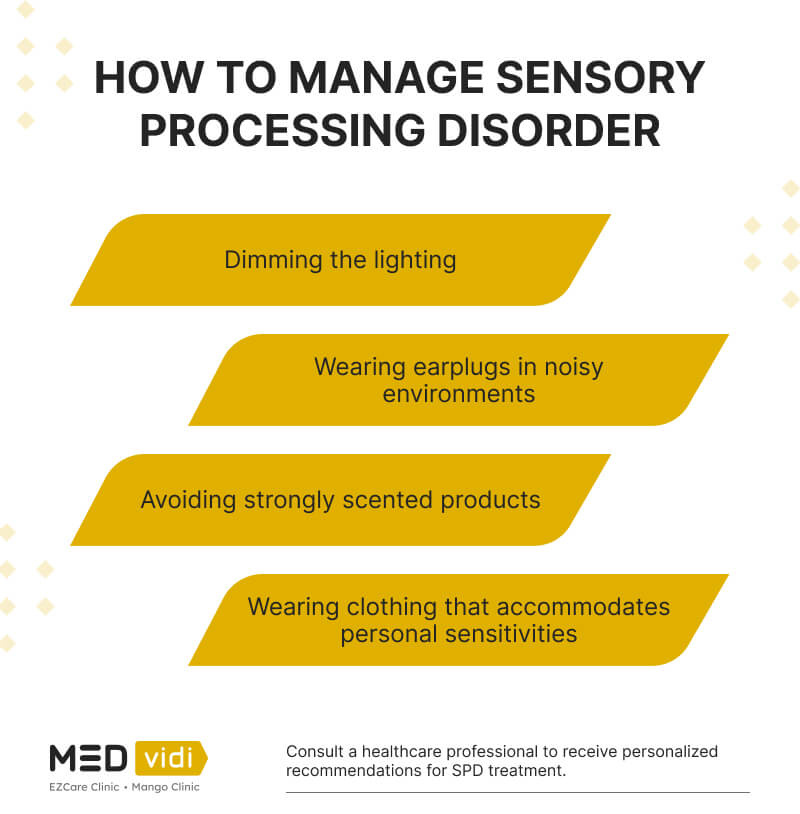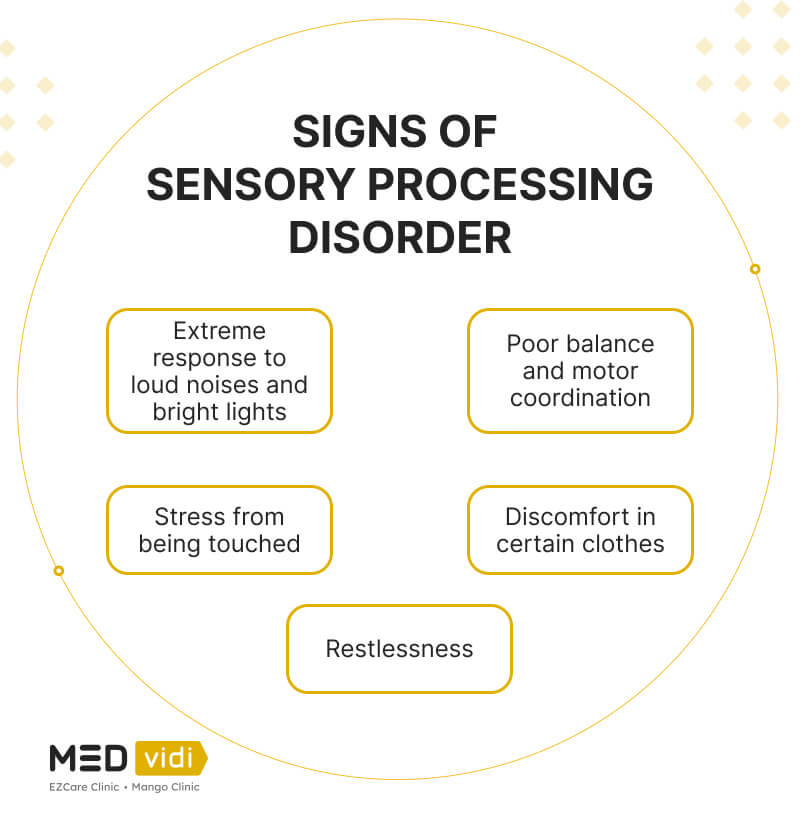Sensory processing disorder (SPD) is a mental condition that makes it difficult for the brain to receive and process sensory information. The symptoms usually occur in childhood and can persist to adulthood if left untreated. Treatment for SPD is available, but there is a chance of misdiagnosis due to the complexity of the condition. Read on to learn important facts on proper diagnosis and treatment plans of SPD.
Schedule an appointment and see a mental health expert online today.
Adult Sensory Overload Explained
Sensory overload happens when any senses (taste, sight, smell, hearing, and touch) process excessive input, overwhelming the brain’s response. This can trigger freezing, panic, or flight response. Normally, the brain uses the senses to process information from the environment, but people with SPD struggle to process it, which results in emotional struggle and heightened sensitivity to certain sounds, sights, or textures. Common triggers include crowded events, heavy traffic, strong smells, physical contact with people, and intense emotions.
What Does SPD Feel Like in Adults?
In a nutshell, SPD reveals itself in the following ways:
- Motor functioning. Patients get clumsy when performing complex motor activities like driving or running machinery.
- Auditory functioning. Common or sudden loud sounds can bother adults with SPD more than others. Regular sounds might also bother them.
- Visual sensitivity. Bright lights or rapid movements can be hard for them to handle. They might get tired or find it tough to focus in busy places.
- Vestibular functioning. Walking on uneven surfaces and riding in escalators, cars, and park rides becomes a struggle for individuals with SPD.
- Tactile functioning. Certain types of clothing, lights, unexpected touches, or being in crowded situations make people with SPD feel uncomfortable.
3 Common Patterns of SPD
Recognizing the differences among different types of SPD is important when seeking assistance. These include:
- Sensory discrimination disorder. Patients have trouble identifying and distinguishing between different sensory stimuli, such as sounds, smells, tastes, and textures.
- Sensory modulation disorder. This pattern affects how people process and react to sensory information. Individuals with this pattern might be hypersensitive (over-responsive) or hyposensitive (under-responsive).
- Sensory-based motor disorder. Patients struggle with planning and coordinating movements, as well as maintaining balance in response to sensory input. These challenges can affect handwriting, tying shoelaces, or using utensils.
Discuss your concerns about mental health in a stigma-free environment at MEDvidi.

Common Causes of SPD in Adults
SPD is a neurological condition with several possible causes, including ongoing efforts to understand its links to autism and genetic factors. SPD symptoms can start from abnormal brain activities, yet the triggers for symptom manifestation remain uncertain. Overall, specific potential causes include:
- Prenatal or birth complications.
- Low birth weight (less than 2.2 kg).
- Premature birth (46% of children born within less than 32 weeks may present SPD).
- Parental stress.
- Alcohol and drug consumption during pregnancy.
- Genetic factors.
- High exposure to chemical agents during childhood.
- Poor sensory stimulation.
General SPD Symptoms in Adults
Early SPD warning signs include sensitivity to loud sounds, lights, and certain fabrics, and discomfort with close interaction. If ignored, these symptoms can become severe and affect relationships, work, and other areas of life. Other symptoms are the following:
- Overwhelmed or underwhelmed response. Some individuals may feel overwhelmed by even minor sensations, while others experience minimal response to stimuli.
- Overstimulation. Sensitive sensory input can trigger clumsiness, fidgetiness, frequent touching of particular objects, and distress to lights and sounds.
- Poor organization skills. Tackling tasks becomes nearly impossible with SPD. If the condition escalates, this leads to immense frustration and anger.
- Distraction. SPD patients struggle with sustained concentration due to frequent distractions from their environment.
- Coordination and muscle tone issues. People with SPD can develop coordination and movement issues. It can result in awkward movements when trying new tasks requiring good balance or hand-eye coordination.
- Changes in academic performance and language skills. Some people with SPD may face problems in their occupational or academic areas.
- Low self-esteem. Patients may avoid challenging activities because of an inner fear of failure. These symptoms can lead to depression and hopelessness, further deteriorating SPD.
- Difficulty adapting to changes. Changes in routine or environment might be more challenging for adults with SPD to adapt to, causing stress and anxiety.
Sensory Processing Disorder and ADHD
Sensory processing disorder and ADHD (attention deficit hyperactivity disorder) are two distinct neurological conditions, yet they can often coexist and overlap one another.
How ADHD and SPD Differ
ADHD is a neurodevelopmental disorder primarily characterized by inattention, impulsivity, and hyperactivity. In contrast, SPD is a sensory integration disorder related to difficulties in processing and responding to sensory information from the environment. While ADHD involves executive issues like planning, organization, and time management, SPD focuses on sensory processing challenges like writing, reading, and coordination. In ADHD, impulsive behavior isn’t tied to sensory input, whereas in SPD symptoms manifest as responses to sensory input.
The SPD Diagnostic Criteria
While some medical bodies recognize SPD, it’s not included in the DSM-5 by the American Psychiatric Association, making diagnosis complex. Health professionals may use childhood history, behaviors like eye movements, response to stimuli, and body balance to reach an SPD diagnosis. Comprehensive evaluation includes the assessment of prenatal, childbirth, and developmental stages, along with questionnaires. This helps rule out other neurological disorders like autism spectrum disorder (ASD), ADHD, and anxiety disorders. Seeking qualified medical professionals is important for proper diagnosis.
See a mental health professional if you have bothersome symptoms.
Treatment for Sensory Processing Disorder in Adults
There are no standardized approaches for SPD treatment in adults. Doctors usually do not recommend medication for SPD; instead, they may recommend therapies and lifestyle changes tailored to a patient’s unique sensory difficulties, and needs. Therefore, it’s essential to determine how each patient reacts to stimuli and sensory input before creating a treatment program. Below are preferred therapies for SPD in adults:
- Sensory integration therapy.
Sensory integration therapy [4*] helps SPD patients cope with the condition better. Therapists introduce structured and controlled sensory experiences that challenge patients without overwhelming them. This helps improve sensory modulation, integration, and adaptive behaviors, ultimately enhancing an individual’s ability to function effectively in daily activities. - Occupational therapy.
Occupational therapy [5*] is highly preferable for SPD patients, particularly in improving focus through prioritization skills. It helps patients develop better coordination and strength that help them cope well in social and occupational settings. - Sensory diet. This
approach [6*] involves creating a personalized plan of sensory activities that provide the right amount and type of sensory input an individual needs to regulate their sensory processing. By incorporating sensory activities throughout the day, individuals better manage sensory sensitivities, improve attention, and enhance overall sensory integration. - Therapeutic listening. It utilizes auditory programs to activate the auditory system and impact sensory processing and self-regulation. It aims to enhance
auditory processing [7*] , easy learning, and emotional control in those with sensory challenges by delivering precise sound frequencies. - Language and speech therapy. It aims to improve verbal skills in SPD patients by improving oral-motor control, articulation, and vocal quality through targeted exercises and interventions.
- Vision therapy. The program improves eye-motor skills for people struggling with writing, reading, and finding their way into traffic due to SPD.
Generally, the objectives of the mentioned therapies revolve around improving patients’ life skills. In particular, therapists work on motor skills, bilateral coordination, and reaction to stimuli.

Lifestyle Tips for People With SPD
Lifestyle changes can make a big difference for some people with sensory processing disorder. On that note, healthcare professionals advocate a whole list of lifestyle changes to facilitate better results:
- Engage in regular exercise that can be as simple as going for a walk regularly.
- Opt for comfortable clothing, such as compression clothing, to avoid tactile sensitivities.
- Create sensory-friendly spaces at home and work that minimize overwhelming stimuli and provide a calming sensory experience.
- Set a consistent daily routine to help anticipate what comes next.
- Participate in calming activities like art, music, or sensory hobbies.
- Regular meditation can be helpful in focusing on specific sensations and having better control of their responses to them.Slow, rhythmic pressure movements during massage also help regulate heart and breathing rates to the advantage of an SPD patient.
Final Thoughts
SPD often makes individuals feel desensitized or over-stimulated. It may also lead to withdrawing entirely from public settings and preferring to steer clear of loud noises and dazzling lights due to sensitivity. Nonetheless, with proper medical interventions and guidance, SPD is manageable. On that note, seek early professional guidance at MEDvidi to avoid undesirable long-term SPD outcomes.
FAQ
Is sensory processing disorder considered a neurological disorder?
How can you define sensory touch issues?
Sensory touch issues happen when individuals struggle to receive and react to information passed through their sense of touch. People with sensory touch issues may easily get irritated by anything touching their skin or feel overwhelmed after frequent touching in quick succession. This occurs due to physical discomfort caused by the inability to process all these sensations at once. Also, it can stem from something else, such as anxiety about public spaces and concern about personal boundaries.
Which kind of sensory processing disorder severely impacts adult patients?
Among the three SPD types, sensory modulation disorder takes a leading position as the most severe. It is defined as the inability to regulate responses to sensory input. This can impact everyday activities like eating, sleeping, and socializing. Patients’ heightened reactions to sensory stimuli can lead to behavioral challenges, often requiring additional assistance for sensory management.
Does aging affect sensory abilities?
Research on aging’s impact on sensory abilities is ongoing. However,
Can anxiety trigger sensory issues?
Anxiety patients often experience symptoms of sensory processing disorder. Anxiety can affect the perception of surroundings, increasing susceptibility to stimuli. This leads to feeling overwhelmed, stress, sleep problems, and gastrointestinal issues.














